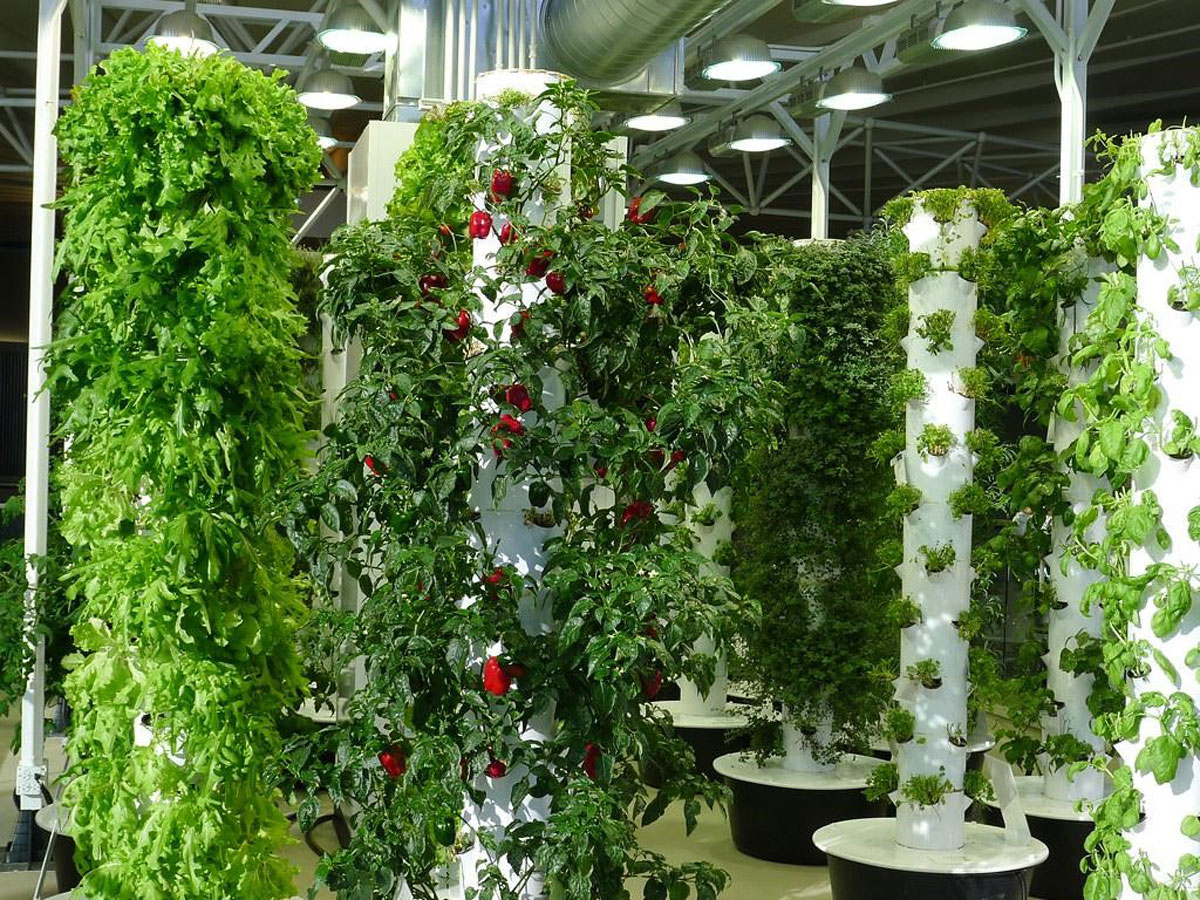Skyscrapers came to dominate urban downtowns as construction techniques advanced and businesses recognized that taller buildings meant more space to rent. Now, the future of offices is uncertain but the demand for food continues to increase. Some entrepreneurs are convinced that the answer is again to go vertical. But are they right? And if so is vertical farming relevant to smallholder farmers?
Green walls, vertical gardens, and more
Academics recognize two general approaches to vertical farming. In some urban centers, you can find gardens on the rooftops of tall buildings, or vegetables growing on balconies. Other buildings have “green walls,” or vertical gardens attached to exterior walls on the sides receiving the most sunshine. These systems are outdoors and rely on sunlight and rain, though oftentimes these urban vertical “farms” are irrigated as well.
“It takes comparatively less time than traditional farming methods to feed a growing global population amid a decrease in arable land.”
Then there are the indoor stacked systems, where food is grown on specialized racks stacked as high as the ceiling. Some innovators build transparent greenhouses to encase these types of vertical farms, taking advantage of the sunlight. For example, Sky Greens, a company in Singapore, grows food on rotating racks inside large greenhouses so its crops can take turns soaking up the sun. The rotating rack systems also make it easier to manage and harvest crops at lower levels. Other startups, like AeroFarms in New Jersey, convert abandoned warehouses into indoor controlled farming operations relying on artificial lighting.
Proponents call vertical farming the future of farming in a world running out of space to grow food. “Vertical farming has emerged as an alternative way for providing more plant-based food,” said Chris Bolton, CEO of Sprout AI, Inc., in his white paper. “It takes comparatively less time than traditional farming methods to feed a growing global population amid a decrease in arable land.” For example, Bolton claims that Sprout AI can grow basil in just 21 days versus over 40 days the usual way. Vertical farming acolytes say the benefits to these systems go beyond the ability to grow more food quickly on relatively small acreages. Many modern vertical farming operations are located in or near urban centers, so it takes less time and energy to deliver crops to markets. Vertical farms also consume far less water than standard farms, especially if they’re enclosed.
Cost prohibitive, for now
Though most vertical farming entrepreneurs have set their operations up in or near cities (part of the growing “urban farming” movement) there’s no reason vertical farms can’t be located in rural areas, or even at smallholder rural farms. Experts agree that these systems can be adapted to grow food pretty much anywhere. Still, the concept hasn’t exactly swept the Earth. There’s a reason for this, say analysts at Cambridge Consultants. “The costs associated with vertical farming are higher than those of traditional farming methods, and are likely to remain so for some time.” In other words, vertical farming innovators can’t quite get the economics to work for most agricultural sectors.
“The costs associated with vertical farming are higher than those of traditional farming methods.”
For starters, there’s the cost of building vertical growing operations whether they’re located indoors or outdoors—growing food skywards means building tall rack systems and a means to access higher levels. For indoor greenhouse vertical farms, the lighting may be free but there are other expenses involved in building the greenhouse, racks, and irrigation system. And those are just the capital costs–operating costs are also very high under artificial lighting. Researchers at Harper Adams University in the United Kingdom concluded that vertical farming needs a lot more experimentation and innovation if it’s to ever achieve cost competitiveness with old-school, horizontal, in-ground agriculture. “While [vertical farming] has been shown to have potential for the production of a wide range of crops, the technical and economic optimization of VF requires further attention with additional research into maximizing productivity and reducing systems costs being required,” they explained in the Journal of Horticultural Science and Biotechnology (https://www.tandfonline.com/doi/full/10.1080/14620316.2019.1574214).
Costs may never come down enough to compete with field production for grains, or even most fruits and vegetables, only a small fraction of which are currently grown in conventional greenhouses. But the technology could have a number of applications, from dense urban areas to refugee camps.
Getting closer to wider adoption
Vertical farming is an emerging technology still in its infancy, as the Harper Adams University researchers point out. A handful of companies are successfully growing foods vertically and indoors at profit, mainly by locating themselves close to urban cores and specializing in growing smaller stature foods in large quantities, such as micro-greens, herbs, and spices. AeroFarms sells packets of arugula, kale, watercress, baby bok choy, and other small leafy greens and herbs. Sky Greens in Singapore grows spinach, lettuce, and a variety of tropical leafy vegetables popular in Chinese cuisine. The technology’s promise is obvious, namely the ability “to increase crop production per unit area of land in response to heightened pressure on agricultural production,” the U.K. researchers said.
If it can work economically in some urban farming settings, perhaps modified, less-expensive versions of vertical farming may someday lift smallholder farmers as well (pun intended). Vertical farming has received a fair amount of interest from the private sector and may not need Grow Further funding, but it’s a trend we’re watching.
— Grow Further
Photo credit: A miniature “vertical farm” showcased at Chicago O’Hare Airport in 2012. Alvin Kho, Creative Commons.




